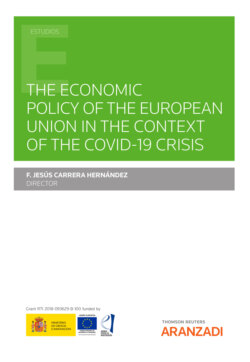Читать книгу The economic policy of the european union in the context of the covid-19 crisis - Francisco Jesús Carrera Hernández - Страница 4
На сайте Литреса книга снята с продажи.
Índice General
ОглавлениеINTRODUCTORY CHAPTER
ECONOMIC GOVERNANCE AND EXCEPTIONAL FINANCIAL ASSISTANCE
F. JESÚS CARRERA HERNÁNDEZ
1.Introduction
2.The triple safety net
3.The recovery instrument
4.Budgetary instruments for the euro area prior to the health crisis
5.The use of art. 122 of the tfeu as the legal basis of the recovery instrument
6.Governance of the new instruments
7.The introduction of conditionality linked to the respect of the rule of law
8.Other questions
CHAPTER 2
THE ROLE OF THE EUROPEAN INVESTMENT BANK DURING THE PANDEMIC
ARIADNA SALAZAR QUIÑÓNEZ
1.Introduction
2.Framework and legal nature of the EIB
3.General assignment
4.Internal organization and functions
5.Role of the eib during the Covid-19 crisis
5.1.Application Areas
5.2.Actions for an Economic Response
6.Parliamentary control of the EIB
7.Conclusion
CHAPTER 3
THE RESPONSE TO THE HEALTH CRISIS FROM THE ECONOMIC AND MONETARY UNION: THE PANDEMIC CRISIS SUPPORT OF THE EUROPEAN STABILITY MECHANISM AND THE FLEXIBILIZATION OF BANKING REGULATION
JORGE URBANEJA CILLÁN
1.Introduction
2.The european stability mechanism as a crisis management mechanism
2.1.The need for a crisis management mechanism for the Eurozone
2.2.The key features of the European Stability Mechanism
2.2.1. The reform of Article 136 of the Treaty on the Functioning of the European Union
2.2.2. Constitution, nature and objectives
2.2.3. Governance and decision-making process
2.2.4. Possibilities for action. Conditionality as an inherent element of ESM programmes
2.2.5. The unborn proposal of the European Monetary Fund
3.From the reform of the european stability mechanism treaty to pandemic crisis support
4.Towards a banking Union
5.The flexibilisation of banking regulation
6.Conclusions
CHAPTER 4
THE MULTIANNUAL FINANCIAL FRAMEWORK
MATILDE LAVOURAS
THAÍS MARTINS
1.Introduction
2.The European Union fiscal policy
3.The multiannual financial framework 2021-2027: characterization and innovations
4.Shaping an EU budget in order to empower the recovery from COVID-19
5.MFF and other transnational challenges
6.Conclusions
CHAPTER 5
THE INSTRUMENT OF RECOVERY AND RESILIENCE, AN UNEXPECTED ADVANCE IN THE EUROPEAN INTEGRATION PROCESS
JOSÉ M.ª PORRAS RAMÍREZ
1.Introduction. The Covid-19 crisis and its high impact on the eu economy
2.Measures initially adopted to protect the single market and provide financial assistance to the member states
3.Additional decisions adopted by the eurogroup to reinforce financial assistance in the Euro Area
4.The recovery instrument as extraordinary expression of solidarity
4.1.Adoption Process, Objectives and Characteristic Features
4.2.Planned Measures and Pillars
4.3.Instruments
4.3.1. The Multiannual Financial Framework (2021-2027) and the new Own Resources System
4.3.2. Recovery and Resilience Facility (RRF)
5.Conclusions
CHAPTER 6
NEW GENERATION EU AND THE EUROPEAN UNION COURT OF JUSTICE
TAMARA ĆAPETA
1.Introduction
2.The new financial arrangement and its coming into being
2.1.Basic legal acts
2.2.The process leading to the adoption of the financial package
3.Legal issues raised by the new financial package
3.1.The competence issues
3.2.Conformity with specific Treaty provisions
3.3.Institutional balance and the basic features of EU law
4.Conclusion
CHAPTER 7
FUTURE PROSPECTS FOR THE INTERNATIONAL ROLE OF THE EURO
VICTOR CALVETE
1.Currency and sovereignty
1.1.Non-Sovereign Currency 1.0
1.2.Currency without sovereignty 1.1
1.3.Sovereignty without currency
1.4.Non-Sovereign Currency 2.0
1.5.Currency without sovereignty 3.0?
2.The state of the euro
2.1.The past
2.2.The present
2.2.1. The state of the internationalization of the euro
a) spatial dimension: the growth of the Eurozone and euroization
b) The temporal dimension: the eventual demise of the euro
c) The virtual dimension: introduction of the digital euro
2.3.The (planning for the) future
2.3.1.Strengthening Monetary Union, Banking Union and Capital Markets Union (Part I)
2.3.2.The Commission’s action plan and the support of the European Parliament
a) The situation
b) Measures in the field of energy
c) Consultations on the adoption of measures to promote the international use of the euro in other sectors
2.4.The (misguided?) strategic reversal
2.5.The waterbed effects
2.6.Strengthening Monetary Union, Banking Union and Capital Markets Union (Part II)
3.Conclusions
CHAPTER 8
EU TRADE POLICY AND THE CASE FOR THE EUROPEAN GLOBALISATION ADJUSTMENT FUND
NOT JUST A BURIAL INSURANCE
FELIPE FIGUEIREDO MARTINS
1.Introduction
2.Competitive advantages and social disadvantages
3.Redistributing the effects of economic integration
4.The EGF
4.1.Definition
4.2.Political and economic rationale
4.2.1. Political rationale
4.2.2. Economic rationale
4.3.Scope
4.4.Procedural aspects
4.4.1. Intervention criteria
4.4.2. Financial ceilings
4.4.3Budgetary procedure
5.EU trade strategies and labour market adjustment costs
6.Conclusion
CHAPTER 9
THE PROPOSAL OF THE EUROPEAN UNION AT THE 75TH UN GENERAL ASSEMBLY FOR THE POST-COVID 19 WORLD
ISABEL CABRITA
JOSEP BORRELL
EUROPEAN COUNCIL
1.Background
2.EU’s strategic goal for the post-covid-19 crisis world
3.EU’s political priorities and objectives for the post-Covid-19 crisis world
3.1.Championing multilateralism and a strong and effective UN that delivers for all
3.2.dvancing human rights and gender equality
3.3.Promoting peace and security
3.4.Building a fair globalisation
3.5.Accelerating the global transition towards sustainable and climate-neutral future
3.6.Leading the transition to a new digital world 281
4.Key findings and final observations
